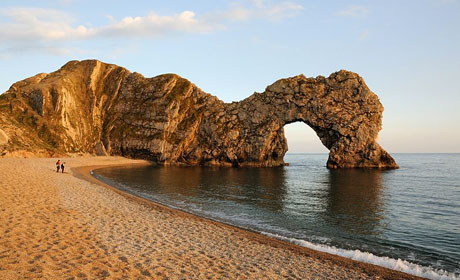Lulworth
Dorset, England

Lulworth Cove, Dorset, is a small, almost circular bay with a narrow opening to the sea.
Together with the adjacent cliffs and St Oswald's, Mupe and Worbarrow Bays it is the best example in Europe of the interaction of marine erosion on an alternating sequence of hard and soft rocks. For this reason alone it is visited by more school children and students than any other locality in Britain.
It is also visited by a large number of tourists who come simply to see the beautiful cliffs and bays. For those interested in the geology and the history of the Earth it has much more.
The rocks form an unbroken sequence from Jurassic limestones to the Cretaceous Chalk, exposed in cliffs up to 150 metres high. They provide a continuous record of about 80 million years of the Earth's past geography and climates.
Aerial view eastwards from Durdle Door to Kimmeridge Bay.

The vertical limestone of the Chalk forms a long sinuous spine that runs from the coast at Durdle Door eastwards to Ballard Down at Swanage.
To the north of this ridge, to the left of the photograph (below), soft Tertiary sands and clays form low ground which until medieval times was occupied by bogs, swamps and forests which effectively separated the 'Isle of Purbeck' from the mainland.
To the south of the Chalk ridge the hard Portland Stone limestone forms a second ridge, but this has been breached by the sea which has then eaten into the softer Purbeck, Wealden and Greensand sediments to form St Oswald's Bay, Lulworth Cove, Mupe Bay and Worbarrow Bay.
Stair Hole and the 'Lulworth Crumple'

The alternations of hard limestone and soft mudstone that make up the Purbeck Beds have responded differently to the enormous pressures which formed the monoclinal fold.
The limestones have fractured but have remained as almost continuous layers, whereas the mudstones have sheared and flowed to fill the intervening spaces.
On the east side of Stair Hole, the massive Portland Stone limestone protects the mudstones from erosion by the sea. The small breach in the limestone on the west side (foreground of the photo above) has allowed the hole to develop in the soft Purbeck Beds and Wealden.
Text Reproduced with the permission of the British Geological Survey ©NERC. All rights Reserved
Durdle Door
The natural sea arch at Durdle Door (top photo) is cut through steeply dipping Portland limestones, and erosion on the landward side of the arch has scoured out the softer Purbeck limestones and Wealden sandstones and siltstones.
Text courtesy of Howard Colley
Related Links
Grid References
- Lulworth Cove: SY 825799
- Durdle Door: SY 805803
Middle and Botttom images reproduced with the permission of the British Geological Survey ©NERC. All rights Reserved

October 13 - 21
Theme: 'Earth Science in our lives'
